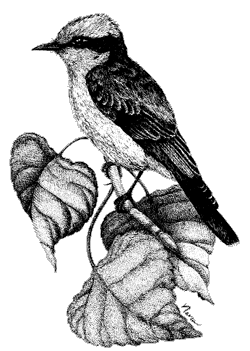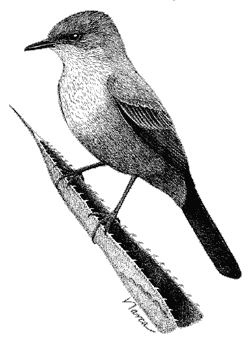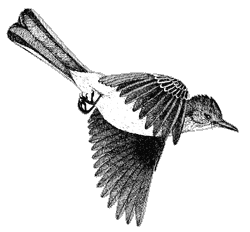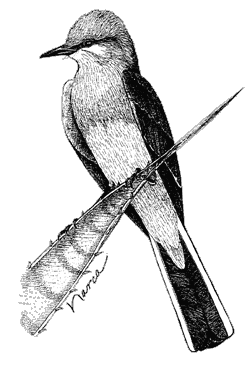Tyrant Flycatchers
Birdwatchers are sometimes driven to despair by the challenge of telling the various flycatchers apart. Many of the species look virtually the same. Birds have to be able to recognize their own kind, of course, at least during the breeding season, but the flycatchers evidently do so mostly by voice. In the Sonoran Desert, for example, the Brown-crested and Ash-throated Flycatchers are almost identical except for size, but their songs and calls are different. Perhaps capitalizing on their need for vocal distinctions, many flycatchers have “dawn songs,”seldom heard later in the day.
 |
Flycatchers in North America feed mainly on insects, and forage by watching from an exposed perch and then sallying forth to pick flying insects out of the air. In this they are aided by their wide, flat bills, and by the bristles on either side of the bill. The little beardless-tyrannulet is so called because it lacks these bristles; it may have less need for them, since it often takes insects from the surfaces of leaves.
The family name of “tyrant” flycatchers reflects the aggressive nature of some species, which drive away much larger birds that venture too near their nests. The kingbird group, represented here by the Western Kingbird, provides the best example of this behavior. Seemingly more gentle are the phoebes, soft-voiced flycatchers that often nest near houses or bridges.
Although most flycatchers are dull-colored, a striking exception is the Vermilion Flycatcher, a relative of the phoebes, common along streams in the desert. The male glows red and black, and in his courtship display he puffs himself up like a ball and flutters about the sky while singing madly, in brilliant contrast to the drabness of his relatives.
—Kenn KaufmanTyrant Flycatchers
Representative Sonoran Desert species:
 |
Northern Beardless-tyrannulet (Camptostoma imberbe)
Vermilion Flycatcher (Pyrocephalus rubinus)
Black Phoebe (Sayornis nigricans)
Say’s Phoebe (Sayornis saya)
Ash-throated Flycatcher (Myiarchus cinerascens)
Brown-crested Flycatcher (Myiarchus tyrannulus)
Western Kingbird (Tyrannus verticalis)
Order: Passeriformes
Family: Tyrannidae (Tyrant Flycatchers)
Spanish names: mosquerito copetón, mosquero (flycatcher)
Distinguishing Features
Northern Beardless-tyrannulet: The smallest flycatcher in the United States, nondescript, gray-olive above and very pale gray below. The name “beardless” refers to the absence of the long rictal bristles at the base of the bill that are characteristic of most flycatchers. Vermilion Flycatcher males: brilliant red head and underparts and black mask, back and wings. Females: streaks on a white breast, brownish head, pale salmon or pink belly. Black Phoebe: Slate black except for white underparts; its fee-bee call is a typical sound along riparian areas in the Southwest. Say’s Phoebe: Pale-gray back, dark tail, and rust-colored underparts. Ash-throated Flycatcher: Brown bushy head, very noticeable whitish-gray throat, light yellow belly, olive-brown back, rust-colored primaries and tail feathers. Brown-crested Flycatcher: Largest of its genus; olive-brown above, black bill, pale gray throat and breast, pale yellow belly; reddish tail and primaries are easily seen in flight. Western Kingbird: gray head, whitish-gray throat and upper breast, pale yellow underparts; the blackish tail has white margins.
Habitat
Northern Beardless-tyrannulet: woodland and stream thickets; found most often in stands of mesquite or cottonwood- willow in southern Arizona. Vermilion Flycatcher: most commonly found near streams or ponds but also frequents grassland and desert habitats with scattered trees. Black Phoebe: prefers shady areas near water including streams, ponds and walled canyons. Say’s Phoebe: Unlike the Black Phoebe, often found in very dry open or semi-open country, far from water; typical of prairies, badlands, and ranch country. Ash-throated Flycatcher: frequents desertscrub, pinyon-juniper, oak groves, creek bottoms, and dry open woodland. Brown-crested Flycatcher: found in association with saguaros; also frequents river groves and other areas where trees are large enough to provide sites for cavity nesting. Western Kingbird: found in semi-open country, farmland, roadsides, and in riparian vegetation.
Feeding
• Diet: Mainly insects
 |
• Behavior: Unlike other flycatchers which capture insects while flying, the Northern Beardless-Tyrannulet often moves along twigs in search of slow-moving insects. During the summer this species also forages in a more typical flycatcher manner: by flying from its perch and catching insects in its bill.
The Vermilion Flycatcher forages by watching from a perch and either capturing flying insects in the air or hovering and dropping to the ground.
The Black Phoebe is often seen perched over the water, slowly wagging its tail, and then darting out to capture an insect in the air, often just above the water’s surface; occasionally takes small fish.
Because they frequent areas that lack high trees, Say’s phoebes either perch on a low shrub and rock and dart out to capture prey, or hover over fields in search of insects in the grass.
The Ash-throated Flycatcher typically forages by flying out from its perch on a dead upper branch of a tree to hover and pick insects from foliage; seldom takes insects in midair; diet is mostly insects, but spiders, saguaro fruit, elderberries, desert mistletoe berries, and even small lizards, are also eaten.
The Brown-crested Flycatcher typically forages by flying out from its perch to hover and pick insects from foliage; also takes insects in midair or from branches or trunks of trees; will perch in shrubs and cactus to eat fruit; diet is mostly insects, but lizards are also eaten.
The Western Kingbird forages by watching from a perch and then flying out and either snapping up insects midair or taking them on the ground by hovering and diving; diet consists mainly of insects but also includes spiders, millipedes, berries, and fruits.
Life History
Northern Beardless-Tyrannulet: The baseball-sized nest is typically well camouflaged in trees or large shrubs. One to 3 white eggs have small, brown and gray dots. Nesting behavior, incubation details, and development of the young are poorly understood.
Vermilion Flycatcher: The male has a rather showy courtship display that involves fluffing up the feathers while rising vertically in the air and hovering, then swooping back to its perch or fluttering slowly to the female. The nest is built by the female in the horizontal fork of mesquite, willow or cottonwood, and other trees. The nest, which consists of twigs, grass and weeds, is lined with feathers or hairs and is often held together by spider webs. The 2 to 4 heavily spotted cream-white eggs take 14 to 15 days to incubate. Only the female incubates the eggs but both parents feed the young until they fledge at 14 to 16 days.
Black Phoebe: The male’s courtship display includes fluttering in the air with rapidly repeated calls, then descending slowly. Black phoebes are solitary nesters that often return to their nest site year after year. The nest is made of mud, grass, and weeds and is usually found in a sheltered spot such as a cliff face or on the support strut of a bridge. Three to 6 eggs are incubated by the female and hatch in 15 to 17 days. The young, which are fed by both parents, leave the nest about 2 to 3 weeks after hatching.
Say’s Phoebe: The nesting site varies greatly—it may be on a rocky ledge, under the eaves of a barn, under a bridge, or even in a well or mine shaft. The nest is made of grass, weeds, twigs, wool, moss, spider webs, and other materials. Unlike the Black Phoebe, no mud is used in its construction. Three to 7 eggs take 12 to 14 days to incubate. Both parents care for the nestlings. The young leave the nest 14 to 16 days after hatching. These birds are not shy of people and adapt well to changes to their natural landscape; populations appear to be stable.
Ash-throated Flycatcher: The nest is usually in a cavity or in an existing hole, but may also be found in a variety of other—often unlikely—places like mailboxes and exhaust pipes. The nest consists of a mass of grass, hairs, weeds, and twigs lined with softer material. Three to 7 creamy- or pinkish-white, blotched or streaked eggs are incubated by the female and hatch in about 15 days. Both parents feed the nestlings, which are ready to fly 14 to 16 days after hatching.
This species will use nest boxes put out for bluebirds.
 |
Brown-crested Flycatcher: This species is aggressive and conspicuous during nesting season. They arrive after most other hole-nesting birds and therefore may have to compete for nest sites. The site is in a cavity in a tree or giant cactus, usually in holes excavated by woodpeckers. Both sexes help with the construction of the nest in the cavity. Plant fibers, hair, feathers, and other debris are used. Three to 6 white to pale buff blotched eggs are incubated by the female. Young hatch in 13 to 15 days. Both parents feed the nestlings and first flight takes place 12 to 18 days after hatching.
 |
Western Kingbird: Nest sites vary and may include tree limbs, utility poles, cliff ledges, and abandoned nests of other birds. Grass, weeds, twigs, plant fibers and softer material for the lining are used in the construction of the cup-shaped nest. Three to 5 white and heavily blotched eggs take 18 to 19 days to hatch. This spunky bird will harass hawks or other large birds that stray too close to its nest. After the young fledge, typically 18 to 19 days after hatching, it is not uncommon to see 6 or more kingbirds burst out of a tree in search of insects.
The Kingbird has adapted well to human encroachment. It has expanded its breeding range and increased its numbers during the 20th century.










